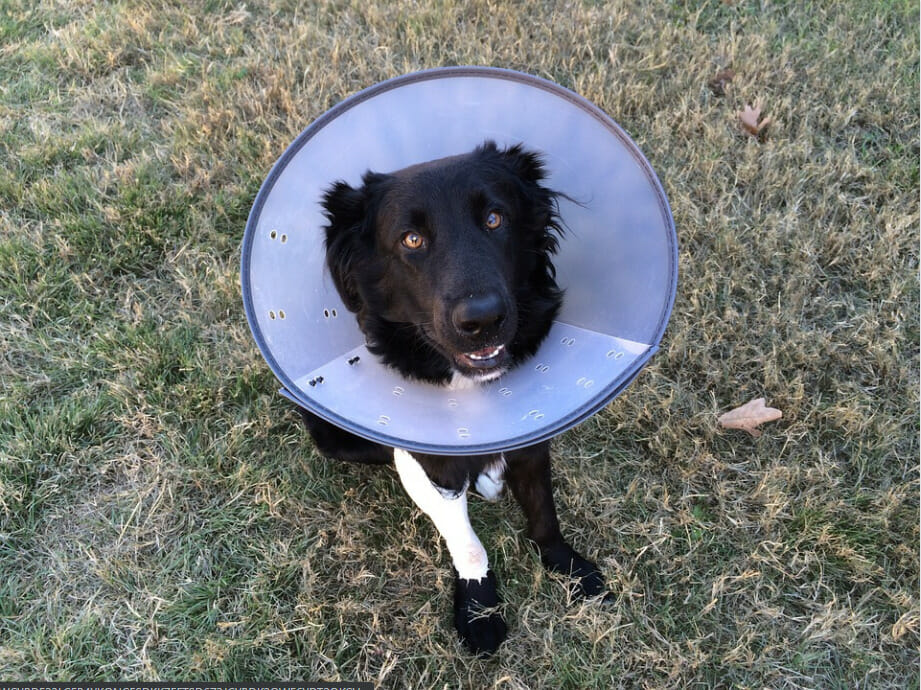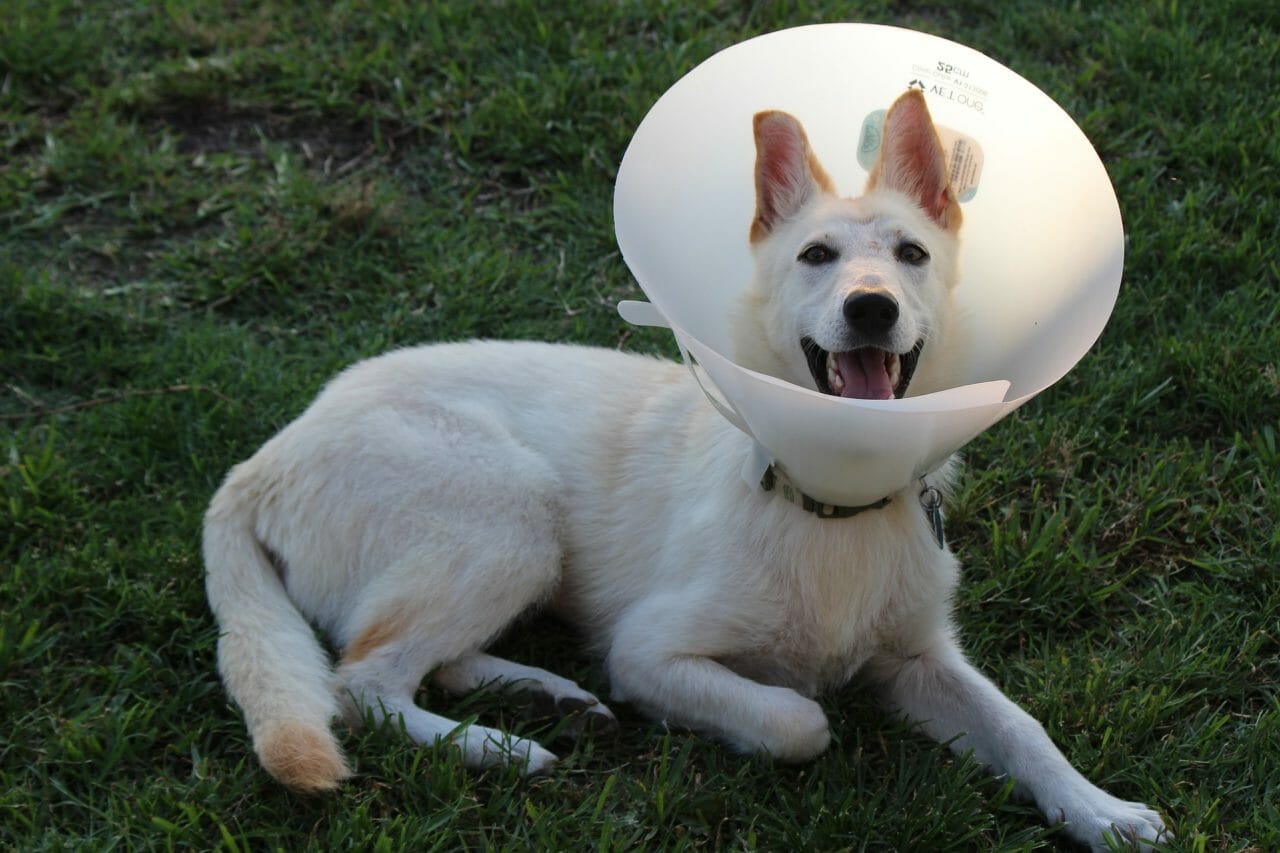Dogs and Cats are experts at hiding signs of pain
Dogs and Cats are experts at hiding signs of pain due to their likelihood of predation in the wild. Most of the signs of pain for cats are similar to dogs. The following are some additions in regards to how our pets might demonstrate pain.
- Posture: Attempting to lay in an abnormal position (curled or sternal if they normally lay on their side)
- Movement: Limited movement when awake
- Vocalization: Hissing or growling, especially when an area is touched.
- Behavior
- Poor grooming – this is a very common sign in the cat
- Rapid, shallow breathing
- Sitting in the back of the cage or hiding under a blanket
- Going off to hide for long periods of time
- Attempts to escape/aggression
- Decreased appetite
Managing Animal Pain
Many options are available for managing animal pain, including:
- Chemical options – drugs and nutritional supplements
- Physical options – massage/manipulation, acupuncture, LASER therapy, and others
- Psychological options – distraction (food, interaction, ways to improve happiness, focus on the big picture)
Chemical Pain Management Options
Prescription Drugs
There are several prescription drugs available to help your pet and the situation they are dealing with. I highly recommend that you work closely with your veterinarian to provide a plan that is best for your pet with their specific ailment and taking into consideration other health problems they might have. I stress that you also need to communicate well with your veterinarian as prescription drugs are an important component to managing pain and it is often quite the balancing act.
I do want to touch on one important subject in relation to prescription drugs. A lot of owners become quite concerned that their pet will have kidney and liver issues from taking prescription drugs – specifically NSAIDS (non-steroidal anti-inflammatory drugs such as Rimadyl or Previcox to name a few). It is correct that this can happen, but if they aren’t used for long periods of time the chances are much lower. It is a balancing act and if pain relief is needed and your veterinarian feels it is warranted, please make sure to use it to decrease the pain your pet is experiencing. I look at it this way – if my pet is in a lot of pain and I can help it, but may reduce their longevity by who knows a few days to a month I would prefer that while they are here with me they are in less pain. However, some prescription drugs have more impact on kidney than others so once again – ask your veterinarian and remember that if one drug isn’t working, sometimes you need to try another one. If all Pets responded to one drug for pain, we would only need one – that is not the case, just like it isn’t the case for humans.
That being said, please don’t forget about these other options and modalities that I discuss below as they are also an integral part of the plan to make your pet’s life better and help them feel better. Sometimes drugs are needed only at first to get rid of the extreme pain and then pain can be managed in other ways. (Read on for more options.)
Nutritional Supplements
Nutritional supplements that can help decrease pain include Omega-3 Essential Fatty Acids (EFAs), glucosamine, and chondroitin and Green Lipped Mussel. There are certainly others, but for the sake of brevity and covering the most common, let’s start with a little on these.
Omega-3 essential fatty acids have been shown to play a role in ramping down inflammation – particularly joint inflammation in osteoarthritis – in both humans and animals. For animals, I do recommend using the actual oil and not giving it to your pet in a gel capsule. Most dogs and cats really like fish oils on their foods, so it is easy to put on their food and mix it in. You do need to make sure to refrigerate the bottle after opening and fish oils can become rancid.
Glucosamine and chondroitin are oral chondroprotective products. Green Lipped Mussel is also a product that seems to have some efficacy to help our Pets with osteoarthritis, however there are only a few studies that demonstrate improvement with use.
Physical Pain Management Options
Acupuncture and TCVM (Traditional Chinese Veterinary Medicine)
Acupuncture is one component of Traditional Chinese Veterinary Medicine (TCVM). TCVM has four main components: acupuncture, herbal medicine, food therapy, and Tui-na (medical manipulation). Acupuncture usually involves the insertion of thin sterile needles into discrete specific points on the body in order to cause a therapeutic effect, but may include other methods such as electrical stimulation (electroacupuncture) or injections of a saline, Adequan or maybe even Vitamin B12 into specific acupuncture sites – this is referred to as aquapuncture.
In traditional Chinese medicine theory, the insertion of needles along meridians regulates the flow of energy (qi – pronounced ‘chi’) through the body. Acupuncture points are located in areas where there is a high density of free nerve endings, mast cells, small arterioles, and lymphatic vessels. Several studies have indicated that stimulation of acupuncture points induces the release of beta-endorphins, serotonin and other neurotransmitters which help decrease pain as well as balance the body’s numerous organ systems and functions.
The physiological effects of acupuncture include:
- Pain relief
- Promotion of tissue healing processes
- Regulation of gastrointestinal motility
- Anti-inflammatory effects
- Immunoregulation (aid in regulation of the immune system)
- Hormone and reproductive regulation
- Antifebrile effects (able to decrease fevers)
In addition to acupuncture, herbal medicine, food therapy and Tui-na are all ways to help our body’s balance and function better and through doing so can decrease pain.
Laser Therapy
The use of therapeutic lasers is becoming more common in veterinary practice. Therapeutic laser is the application of light energy to areas of the body to stimulate healing. This light–tissue interaction is called photobiomodulation. Low Level Laser Therapy (LLLT) is the treatment of various conditions using laser to bring about a reaction based on that wavelength of light at the cellular level. The laser light penetrates into tissue where it is absorbed by cells and converted into energy that influences the course of the metabolic process. The word “laser” originated as an acronym for light amplification by stimulated emission of radiation. Laser light is different from “normal” light because it is of a single wavelength and it is focused (concentrated).
How Laser Works
Low-level laser therapy (LLLT), also known as photobiomodulation (the laser–tissue interaction), is a painless treatment that uses clinically tested wavelengths of light to stimulate natural biological processes leading to faster healing and pain relief. Like plants absorbing sunlight through photosynthesis, cells in the body absorb laser energy that stimulates the body to release pain-relieving compounds, increases circulation and energize the cells to participate in the healing process. There are no side effects and in some cases laser therapy can take the place of pharmaceuticals and surgery to treat long-term, degenerative diseases.
Photobiomodulation creates many consequences in the body’s cells, with the most significant being reduction of pain and enhancement of healing. For example, therapeutic laser reduces pain by decreasing inflammation, as well as by decreasing tissue chemicals that stimulate pain and by affecting nerve conduction.
What types of conditions benefit from therapeutic laser?
The most common applications for therapeutic laser include muscular sprain/strain and the resultant pain, osteoarthritis (laser treatment over joints and muscles that are painful), post-operative application around incisions, wounds (to stimulate and accelerate healing) and any situation in which the pet is experiencing musculoskeletal pain. The following are the most common reasons we would use LLLT.
- Wounds
- Soft Tissue Injuries
- Arthritis
- Tendon and Ligament Tears
- Joint Conditions
- Neurologic Injuries
- Hip Dysplasia
- Degenerative Joint Disease
- Degenerative Myelopathy
- Stiffness and Muscle Soreness
- Post Op CCL surgery
- Lick Granulomas
Are there any reasons not to use a therapeutic laser on a pet?
The therapeutic laser should not be used over areas of active bleeding or over the eyes, testicles, tumors, or pregnancies.
Physical Therapy and Rehabilitation and weight loss
There are several aspects of physical therapy that can be utilized to alleviate pain in patients. Cold therapy, heat therapy , and passive range of motion exercises and massage can all be used to help with pain management. Just getting our Pets up and moving is very important. If that is too painful, then consider looking over previous blog posts on heat therapy and when to use it, cold therapy and when to use that. I suggest if you are at this point that you work with a certified rehabilitation practitioner. There are a few different certification programs, but using a veterinarian that has gone through one of the certification programs can aid in getting your dog or cat feeling better and back to normal!
If your pet is also overweight, you need to work closely with your veterinarian on weight loss goals. Even a few pounds for some of our Pets can make a huge difference in their pain status. The heavier our Pets are the more weight that is on their joints, pressing against organs and just making each move more difficult, challenging or perhaps painful.
Massage Therapy
I like to keep it simple when I am talking with my clients. Massage helps increase local blood flow and blood brings important nutrients into the area to help heal. Healing equals pain relief! Thus, massage equals healing with your hands! I have all the respect in the world for a good massage therapist, but please know that the time you spend massaging your dog or cat is great bonding time and can also be an important component to recovery and pain relief.
Prior to massage, it is good to discuss it with your veterinarian to make sure massage is appropriate for your dog’s pain. An acute (occurred recently) injury or issues should definitely be checked out by your veterinarian. If an injury is acute you should always remember to be EXTRA gentle. If you are massaging and your Pet turns around and looks at you or jumps, you are definitely placing too much pressure on the affected area!
When performing massage I believe it is imperative to remember the concept of compensation. Our Pets are often quite painful and compensating in other areas so think about that when you are massaging.
It is important for you to be relaxed when massaging your dog and just taking a few deep breaths can help with this. I also like to dim the lights and have calming music – if not for my dog, for me! Your dog or cat should be in a quiet room, ideally lying on the floor or a raised bed where they feel comfortable and you are also comfortable. It is best to start with a gentle pressure, slowly massing the affected area in the direction of fur growth to provide initial patient contact and relaxation. Take special note of any areas of discomfort, increased muscle tension or temperature changes. (When checking for temperature changes, I recommend closing your eyes so you can concentrate more on temperature.) I like to start my massage at their feet or toes and work towards their body. When treating their back, work from their rear end to their head.
Pulsed Electromagnetic Field Therapy (PEMF)
PEMF therapy isn’t something your regular veterinarian is going to talk about with you. However, it is a realistic modality that can effectively be used to decrease pain. It is proven to decrease pain for muscle pulls and strains, surgical recovery, bone problems, bone fractures, cuts and bruises, and osteoarthritis.
The most common PEMF units are loops that you can purchase. You basically place the loop over the area of pain that is affecting your Pet and via short pulses of radio-frequency it increases blood flow and can restore a more normal cell metabolism which helps decrease pain. I look at these as more of a ‘band-aid’ to help with pain management. I love using these in dogs with severe back pain post-operatively or just from intervertebral disk disease. They can also help with post-operative pain or recent sprains or pains. You must be careful that your Pet does not eat them and keeping them on your Pet is often challenging, but even an hour of treatment a day can help and possibly decrease pain meds, etc. The therapy is generated from a 3-volt battery similar to those found in watches. The area of effective treatment of a PEMF therapy loop mirrors the size and shape of the area of the antenna that makes up the loop.
(From a more scientific standpoint – these PEMF loops emit a radiofrequency wave in short pulses that create an induced electric field in the damaged tissue in an eddy-like pattern that increases blood flow and restores normal cell metabolism. There is no sensation from the treatment and there are no known side effects.)
There are also PEMF beds that are on the market that dogs or cats can lay on for pain relief.
PEMF Therapy Benefits
Should NOT be used in the following situations
Relieves joint, muscle and tendon pain
Animals with cardiac pacemakers, neurostimulators
Reduces edema and inflammation
Animals that are pregnant
Improves mobility
Animals with known cancer unless palliative care has been chosen
Accelerates healing of wounds, incisions, and bruises

Psychological options/Mental health
Your Pet’s mental or psychological status is really important and if our Pet’s minds are healthy – so are their bodies! I work with a lot of dogs that have been hospitalized for a period of time. If you talk to any human that has been hospitalized for a period of time, they will all tell you that breathing in fresh air and getting outside the walls of the hospital is really important. Our Pets are much the same; being kept inside the hospital and only going outside to relieve themselves is depressing. If your dog has a hard time walking or moving – take them outside to smell the fresh air, take them on a walk in a wagon (make sure it is safe) if they can’t walk, but make sure you get their life as close to ‘normal’ for them as you can. Mental health for our Pets is very important and they need interaction with birds, squirrels and whatever else you might have depending on your living situation.
When my dog Sasha was just about 12 years old, I stopped taking her with me to do simple errands as it was really hard for her to get up into the van and I was worried she was going to hurt herself. One day, she clearly wanted to go out with us so I decided to take her – she got up in the seat in the van and sat there just like she used to and I could see happiness exude from her! I didn’t realize how important her car trips were to her – even though we didn’t really do much this was a time for her that gave her joy! I have made some modifications like helping her up and making it as safe as I can, but just taking her on a few car trips a week really improves her mental state of mind.
If your dog has just had surgery and is required to spend most of his or her time in a kennel, then create some games – hide treats around their kennel, purchase toys that keep their minds stimulated. Here are a few suggestions for mind stimulation games for our Pets. (**look on amazon for some of these toys to keep them busy – I can look for some later as well.)
For some dogs, interaction with other dogs is important – just look at the situation and make sure you can make it as safe for them as you can. For Sasha, she didn’t really enjoy stimulation with other dogs, but she lived for her daily walk! Pending on your pet’s pain status you may have to shorten their walk or make sure the surface they are walking on isn’t painful for them. Whatever the situation, don’t just stop doing things that make them happy – look for a safer way or modify it some, but make sure they interact with the environment around them on a daily basis.
Help Your Pet’s Pain, Improve Their Quality of Life
In conclusion, pain relief is important in our Pets and by alleviating their pain we can improve their quality of life! Our Pets already have much shorter lifespans than the average human. Don’t we want their time with us to be as happy, healthy and as pain-free as possible? I hope you have enjoyed this information about pain relief and will discuss any questions you might have with your veterinarian.
Pain management and pain relief are ongoing processes and we need to make sure we understand that our Pets demonstrate pain differently than we do and we must make sure we are treating them with a combination of therapies to provide the best results. Finally, we must make sure they don’t become depressed as healthy minds lead to healthy bodies.
- If you are in doubt or concerned about your dog or cat’s pain, please consult your veterinarian.
- Use multiple strategies – prescription drugs have their place, but so do some other modalities like acupuncture or PEMF.
- Make sure to communicate with your veterinarian on how effective you think the treatment plan is and work to have it changed if it isn’t helping.
- Remember the final goal is to provide your pet with the best quality of life we can possibly provide.



